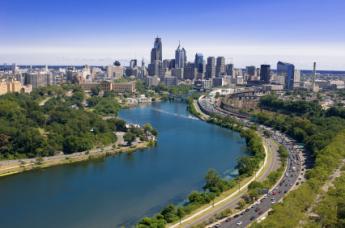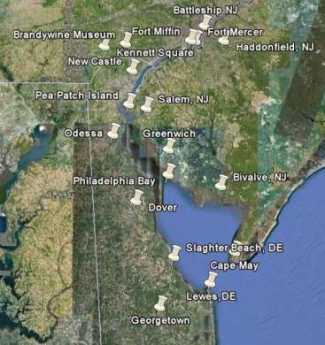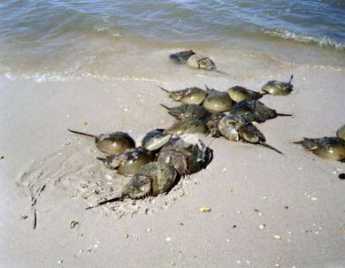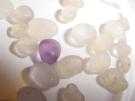Related Topics
Philadelphia, A Running Commentary
A series of observations in and around Philadelphia by notables over the last three and one-half centuries.

Delaware (State of)
 Originally the "lower counties" of Pennsylvania, and thus one of three Quaker colonies founded by William Penn, Delaware has developed its own set of traditions and history.
Originally the "lower counties" of Pennsylvania, and thus one of three Quaker colonies founded by William Penn, Delaware has developed its own set of traditions and history.
City of Rivers and Rivulets
Philadelphia has always been defined by the waters that surround it.
Nature Preservation
Nature preservation and nature destruction are different parts of an eternal process.
Land Tour Around Delaware Bay
 Start in Philadelphia, take two days to tour around Delaware Bay. Down the New Jersey side to Cape May, ferry over to Lewes, tour up to Dover and New Castle, visit Winterthur, Longwood Gardens, Brandywine Battlefield and art museum, then back to Philadelphia. Try it!
Start in Philadelphia, take two days to tour around Delaware Bay. Down the New Jersey side to Cape May, ferry over to Lewes, tour up to Dover and New Castle, visit Winterthur, Longwood Gardens, Brandywine Battlefield and art museum, then back to Philadelphia. Try it!
Gardens Flowers and Horticulture
Gardening, flowers and the Flower Show are central to the social fabric of Philadelphia.
Philadelphia Before the English Settlement
New topic 2012-07-09 15:21:41 description
Delaware Bay Before the White Man Came
Captain John Smith of Virginia, sometime friend of Pocahontas, wrote a letter to Captain Henry Hudson that he understood there was a big gap in the continent to the North of the Virginia Capes, and maybe this was the Northwest Passage to China. Hudson set out to look for it.

|
| Hudson |
Smith's misjudgment now seems like a credible story if you take the ferry from Lewes, Delaware to Cape May, New Jersey. You are out of sight of land for half an hour on that trip, and it's a hundred miles of blue salt water to Philadelphia if you decided to go in that direction. In fact, the bay widens out to double the width or more, just inside the capes, and you can see how an explorer in a little sailboat might believe there was clear sailing to the Indies if you went that way. But as a matter of fact, Hudson encountered so much "shoal" that he ran aground repeatedly trying to sail into the bay, and soon gave up. He encountered a swamp, not an ocean passage. The Hudson River, and later Hudson's Bay, seemed like better bets.
What Hudson had encountered was one of the largest gaps in the chain of Atlantic barrier islands, formed by the crumbling of the Allegheny Mountains into the sea, and then washed up as beach islands by the ocean currents. At various points, the low flat sandy islands became re-attached to the mainland as the intervening bay silted up, and that's why the islands of New Jersey and Delaware seem like part of the mainland. And that's what would have happened to the whole Delaware Bay if it hadn't been ditched and dredged, and wave action diverted with jetties. The swamp was a great place to breed insects, so fish were abundant, and that brought birds in vast numbers. Two stories illustrate.

|
| Horseshoe Crabs |
Once a year, a zillion ugly Horseshoe Crabs crawl out of the sea onto the Lewes beaches, and lay a million zillion eggs in the sand. Almost to the moment, a swarm of South American birds swoops out of the skies to eat the eggs. Those birds started flying months earlier from thousands of miles away, but their timing with regard to Delaware crab eggs is perfect, so this evolutionary semi-miracle must have been going on for many centuries.

|
| Cape May |
Now, coming from the other direction, every hour each fall it is possible to see a hawk or two flies south to Cape May, then sort of disappearing in the woods. And then, at some unknown signal, tens of thousands of hawks rise from the bushes and travel together on the thirty-mile passage over the bay and then go on South. Cape May has lots of migratory birds and bird watchers, and it also has Cape May "diamonds", which are funny little stones washed up at the tip of Cape May Point.
In the spring, vast schools of successive species of fish migrate up the Delaware Bay to spawn in the reeds along the shoreline, but as each school encounters the point where the salt water turns fresh, they stop dead. They mill around at this point for several weeks adjusting to the change of water and then go on about their business. While they are there, it is possible for amateurs to catch amazing amounts of fish, if you know the best time, and if you know where the salinity changes. Since heavy or light rainfall can shift the salinity barrier fifty miles, you have to own your own boat if you want to enjoy this phenomenon, since the rental boats are all spoken for months in advance. Fishermen don't like to tell you about such things; patients of mine who literally owed me their lives have refused to say where I might find the fish this year.
Over on the New Jersey side of the bay, oysters like to grow, although something has just about wiped them out in recent decades. There is a town called Bivalve, which is worth a visit just to see the towering piles of oyster shells left over from last century. For miles around, the roads are actually paved with ground-up oyster shells. Up north around Salem, the shad used to run by the millions until the warm water emerging from the Salem (nuclear) power plant attracted them into the intake pipes and action was taken to abate the nuisance. The Salem Country Cub is one of the few places where planked shad can be obtained in season. The system is to split the fish open and nail it to a board, which is then placed in the big open fireplace to cook, and sizzle, and smell just wonderful good. On the other hand, if you want to buy shad in season (March-May) and cook it at home, the place to get it is in Bridgeton.
At the far northern end, at Trenton, the real Delaware River flows into the bay. The area has long since been dredged, but at one time the "falls" at Trenton were notable. Even today, if you travel upriver almost to Lambertville, you will see the river drop over several small ledges. Actually, rapids would probably be a better descriptive term, since Delaware picks up quite a strong current coming down from the Lehigh Valley. In seasons of heavy rainfall, the falls can be completely "drowned".
And down at Philadelphia where we live, the Schuylkill joined Delaware, forming the largest swamp of all at the river junction, a place once famous for its enormous swarms of swans. The Dutch discovered a high point of land at what is now called Gray's Ferry and made it into a trading place for beaver skins from the local Indians. There seems no reason to doubt the report that they took away thirty thousand beaver skins a year from this trading post, now the University of Pennsylvania.
An English sailing vessel was once blown to the East side of Delaware at what would now be Walnut Street in Philadelphia, and it was recorded in the ship's log that it was scraped by overhanging tree limbs. The high ground at that point seemed like a favorable place to situate a city because the water was deep enough for ocean vessels. They had stumbled on one of the relatively few places in the whole bay that was both defensible and navigable, where the game was abundant, and fishing was good. The rest is history.
Originally published: Monday, June 26, 2006; most-recently modified: Thursday, May 16, 2019